【转】Create Hello-JNI with Android Studio
【转】Create Hello-JNI with Android Studio
访问需要翻墙。
没有翻译成中文是因为图片很详细,看不懂英文,根据图片一步一步也能完成。另外开发人员应该具备阅读英文技术博客的能力。
1. Overview
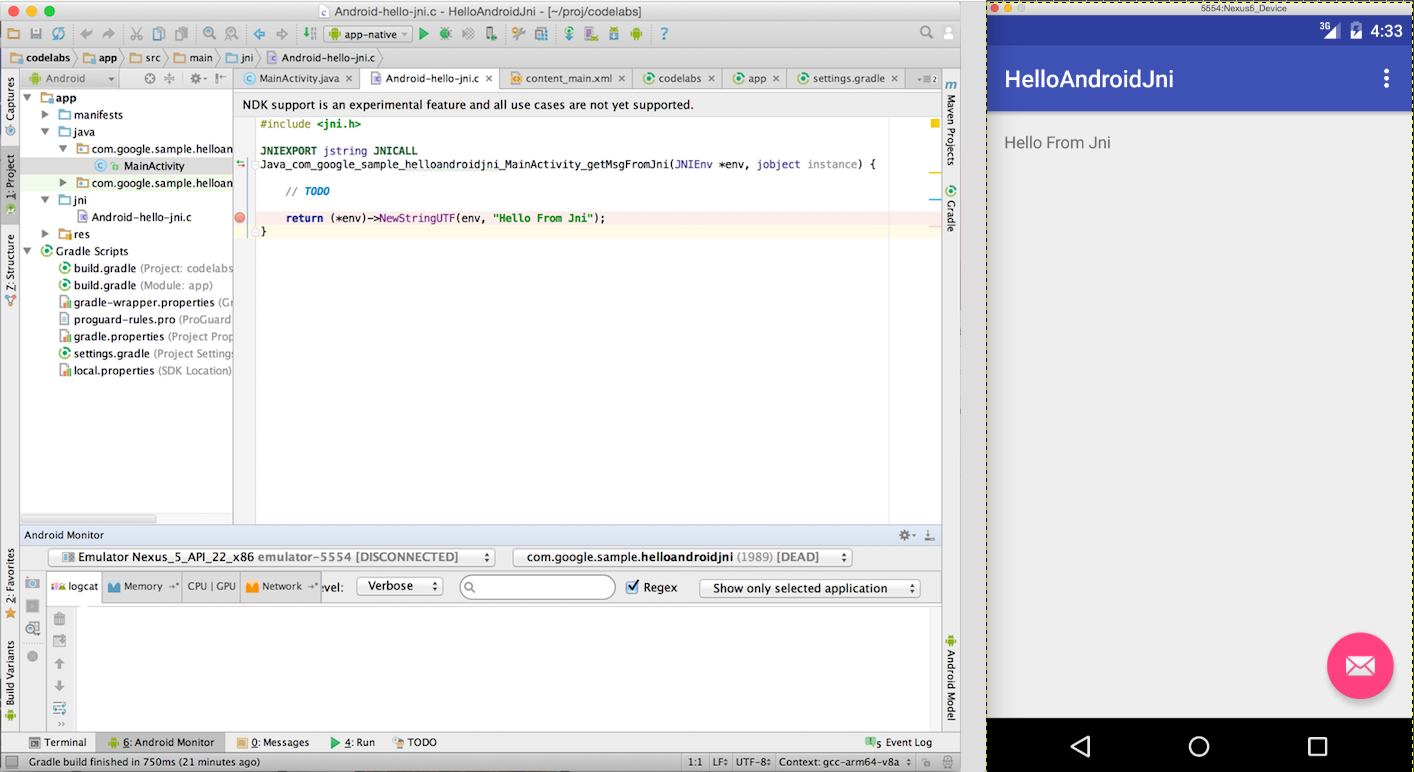
In this codelab, you'll learn how to use Android Studio to start Android NDK project development.
2. Create Java Sample App
- Find and start Android Studio on your development system:
a) Linux: Run studio.sh from your installed location
b) OSX: Find studio installation in Application folder, double click to
start
If this is the first time you run this version of Android Studio on this
system, Android Studio will prompt to import from previous settings, just
select "I do not have a previous version of Studio or I do not want
to import my settings", "Welcome to Android Studio" will be
displayed.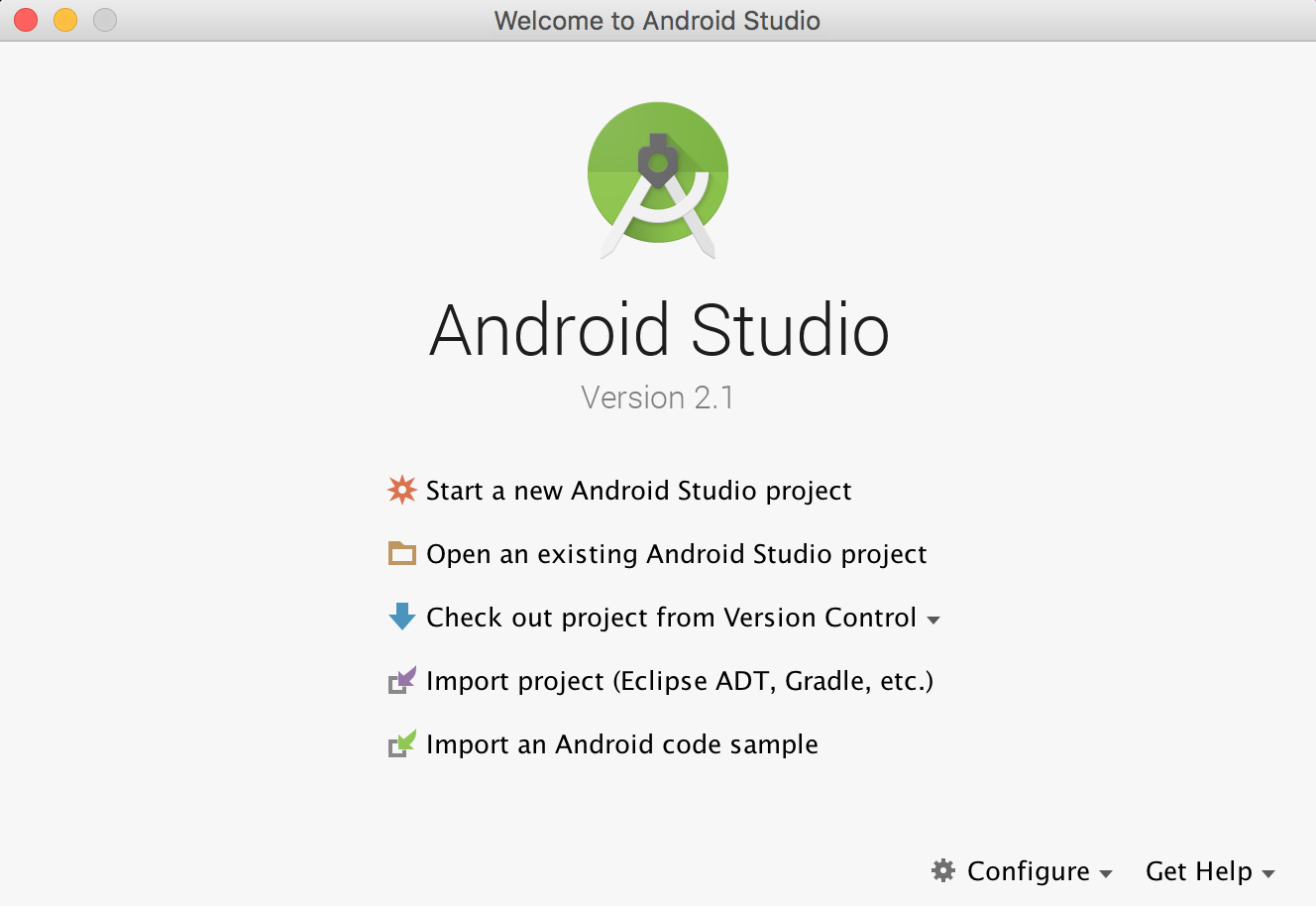
- Select "Start a new Android Studio
project". - On "New Project" page, change
"Application Name" to HelloAndroidJni, and leave the default
values for other fields.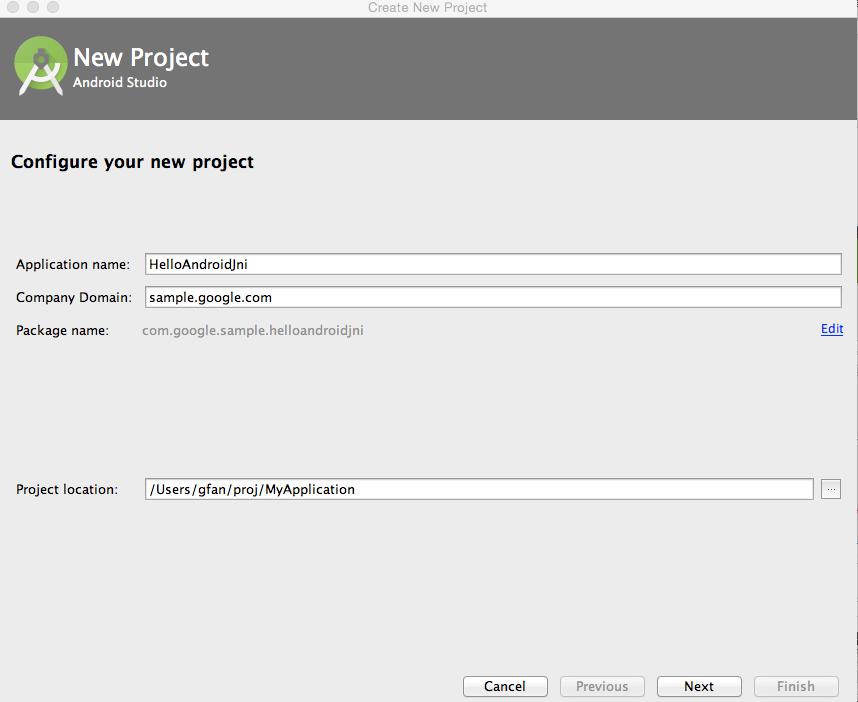
- Click "Next", select "Basic
Activity" as our template in "Add an Activity to Mobile"
page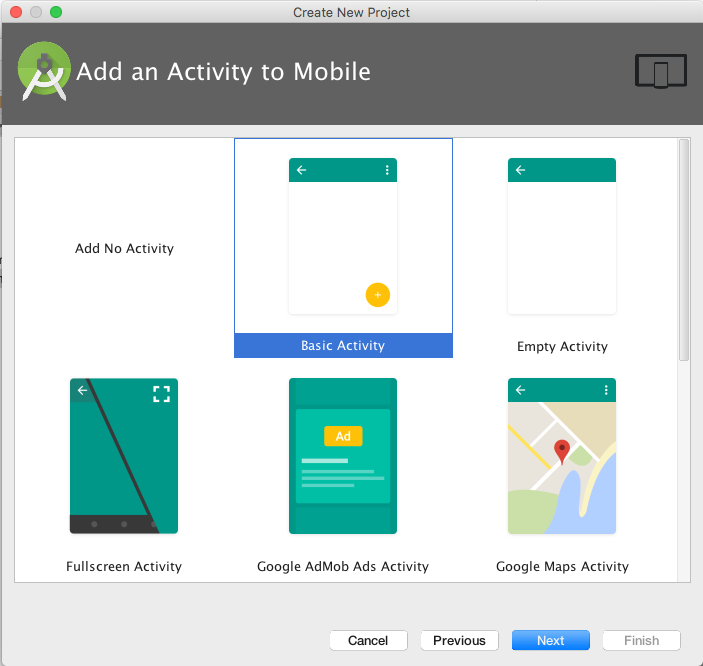
- Click "Next" all the way to
"Finish" to complete application creation.
This creates an Android "Hello World" Java app; your Android
Studio looks like: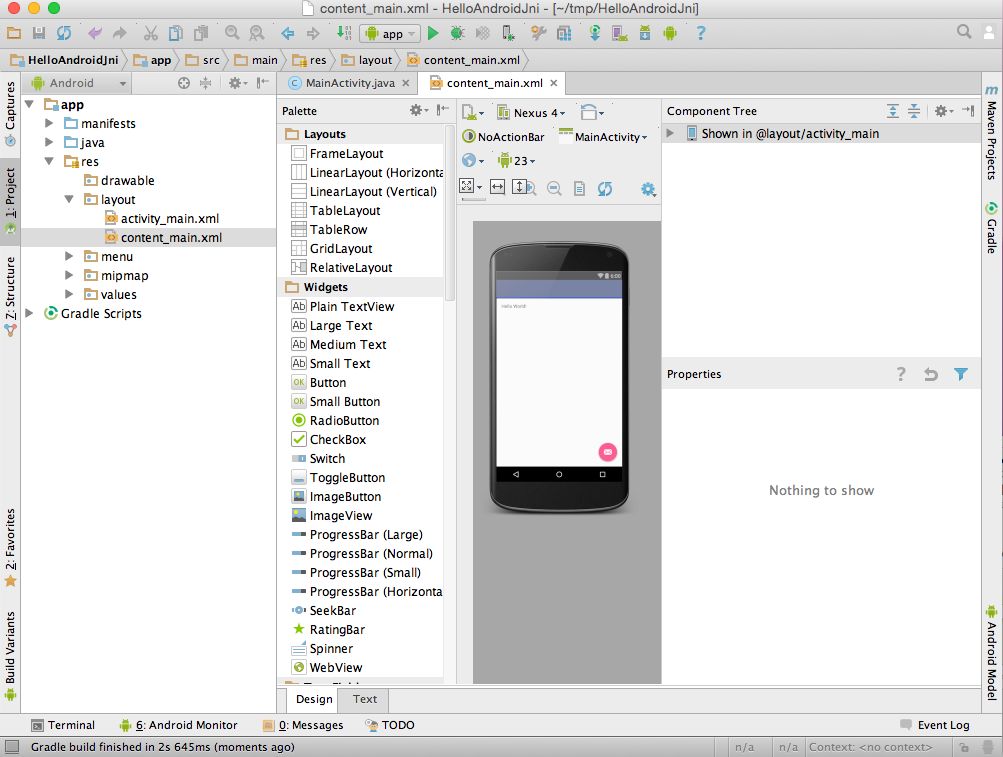
- (Optional) Connect your Android Device with
USB cable if you have device available; otherwise, create an Emulator when
Android Studio prompts you in the next step. - Sync

, Build

and Run , you will see the
, you will see the
following on your target device or Emulator: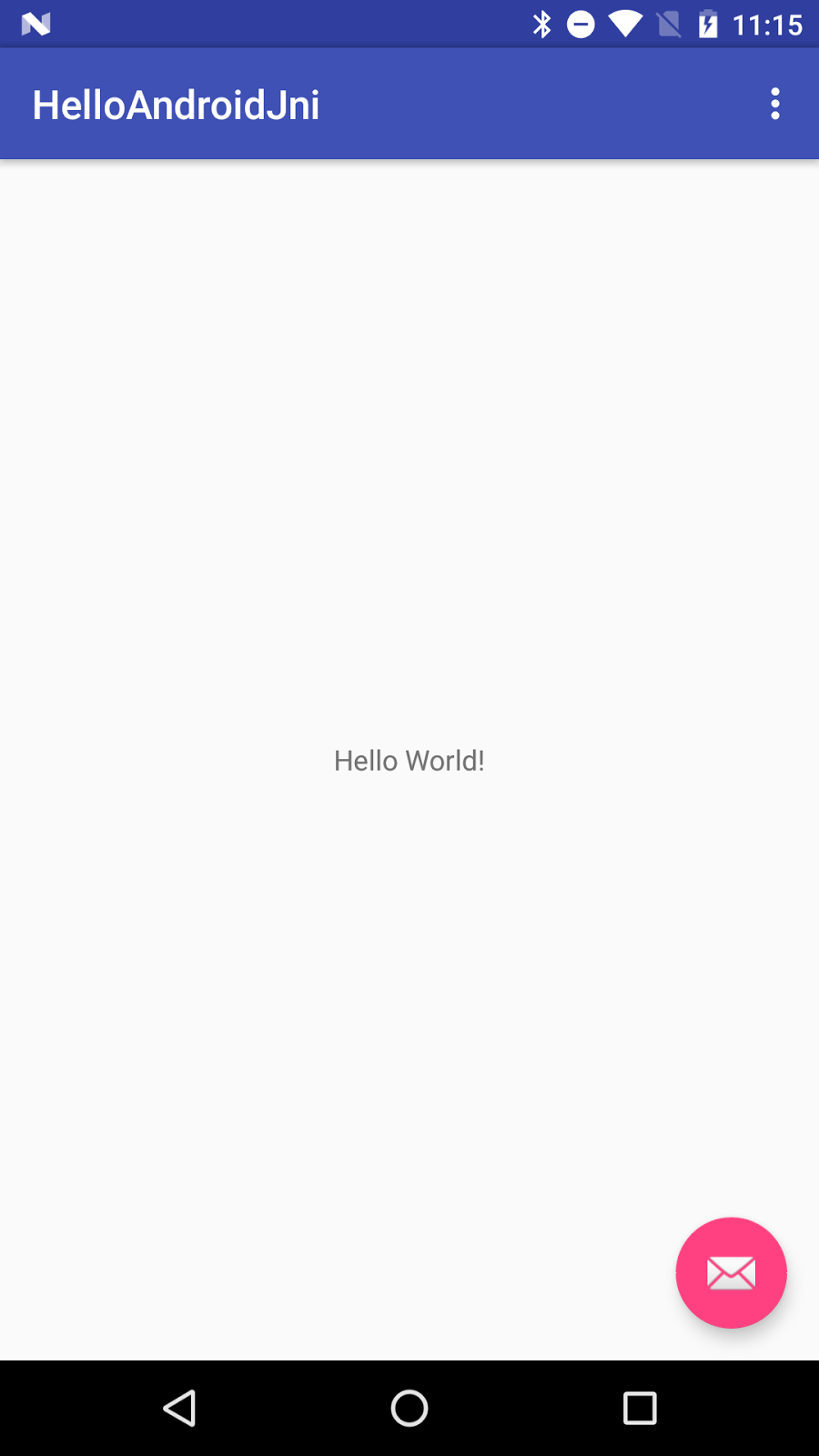
- Configure the project to use gradle wrapper.
a) On Mac OS, menu "Android Studio" > "Preferences".
b) On Linux, menu "File" > "Settings".
c) Then "Build, Execution, Deployment" > "Build Tools"
> "Gradle".
d) Select "Use Default Gradle wrapper (recommended)", click
"OK".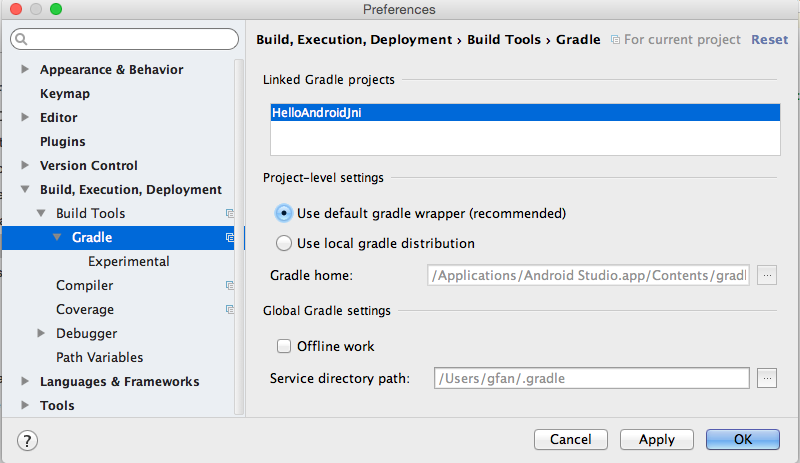
- Configure Android Studio to download NDK
a) Menu "Tools" > "Android" > "SDK Manager"
b) Select tab "SDK Tools"
c) Check "Android NDK"[ or "NDK"] if it is not checked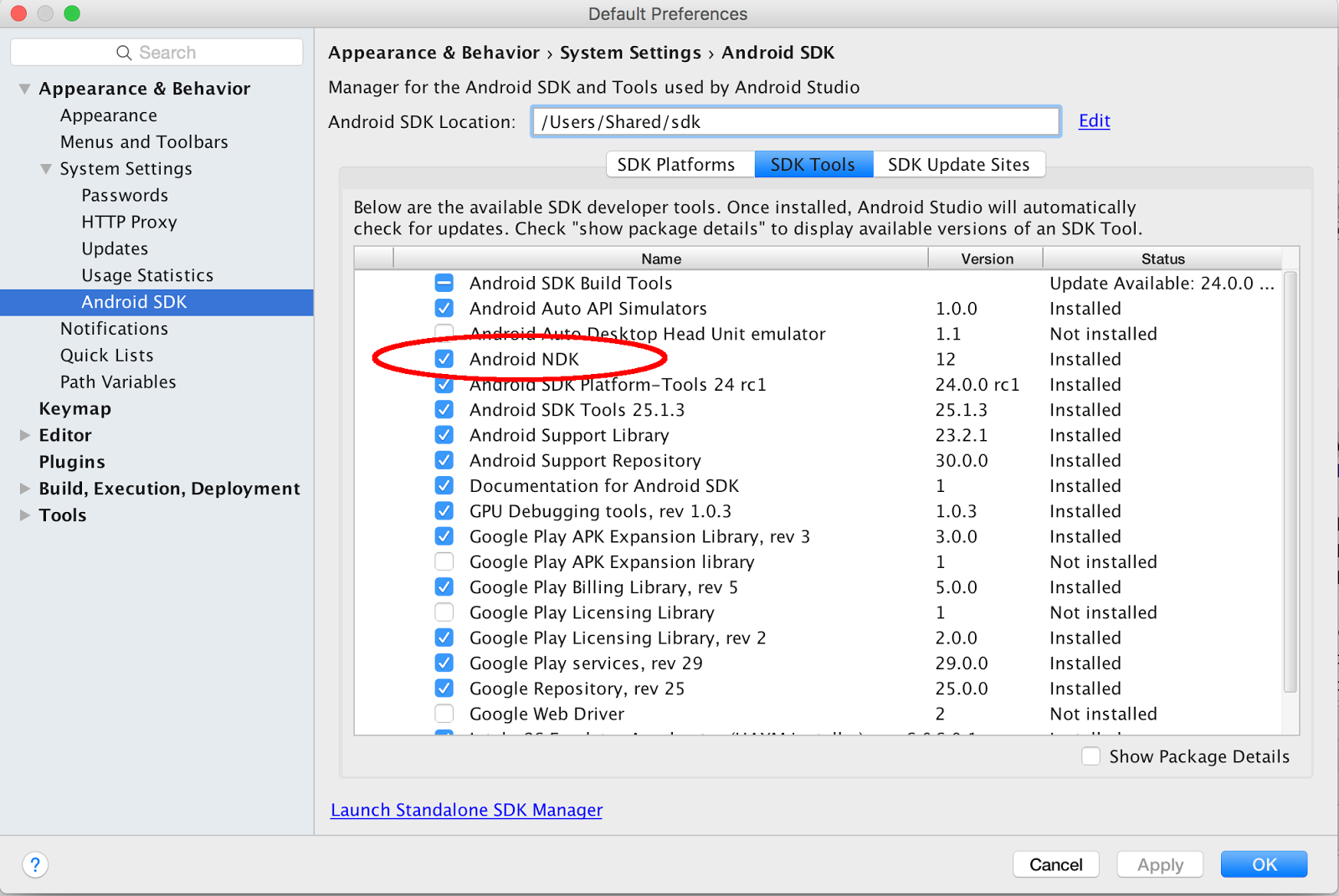
- Sync
 , Build
, Build  and Run
and Run  , you should see the same as in step 6.
, you should see the same as in step 6.
3. Add
JNI Build Capability to HelloAndroidJni Project
Android Studio supports native
development via experimental plugin developed by Google, let's add it into our
project.
- Find the latest gradle-experimental plugin version[currently
is 0.7.2 at the writing]. Open project build.gradle in Android Studio's
"Project" window.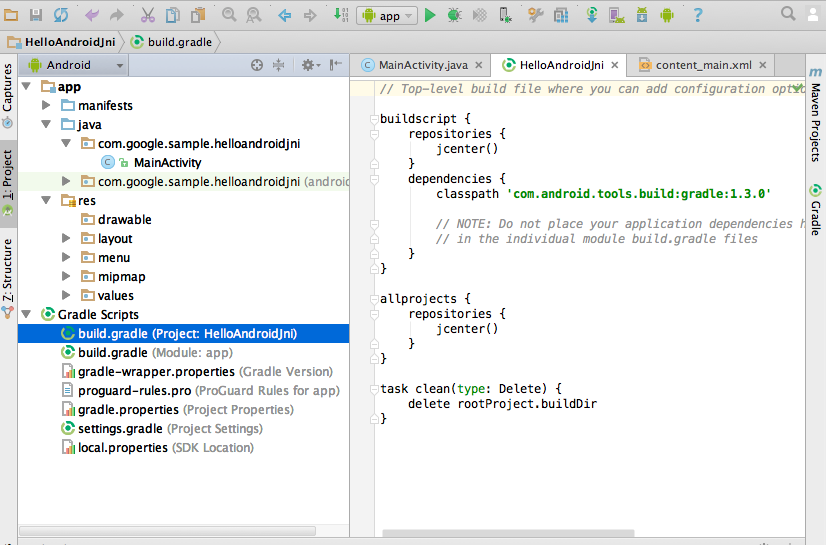
- Replace gradle plugin
classpath 'com.android.tools.build:gradle:2.1.0'
with your latest version[it does not have to be 0.7.2]:
classpath 'com.android.tools.build:gradle-experimental:0.7.2'
- Change to the latest gradle version (2.10 is required for plugin version 0.7.0).
Select Android Studio "Project" pane, "Gradle Scripts"
> "gradle-wrapper.properties (Gradle Version)" and change:
distributionUrl=https\://services.gradle.org/distributions/gradle-2.4-all.zip
to:
distributionUrl=https\://services.gradle.org/distributions/gradle-2.10-all.zip - Convert the auto-generated module build.gradle
to Gradle's component model DSL.
Select Android Studio "Project" pane > "Gradle
Scripts" > "build.gradle (Module: app)" and replace:
apply plugin: 'com.android.application'
android {
compileSdkVersion 23
buildToolsVersion "23.0.1"
defaultConfig {
applicationId "com.google.sample.helloandroidjni"
minSdkVersion 22
targetSdkVersion 23
versionCode 1
versionName "1.0"
}
buildTypes {
release {
minifyEnabled false
proguardFiles getDefaultProguardFile('proguard-android.txt'), 'proguard-rules.pro'
}
}
}
// others below this line: no change
with:
apply plugin: 'com.android.model.application'
model {
android {
compileSdkVersion 23
buildToolsVersion "23.0.3"
defaultConfig {
applicationId "com.google.sample.helloandroidjni"
minSdkVersion.apiLevel 22
targetSdkVersion.apiLevel 23
versionCode 1
versionName "1.0"
}
buildTypes {
release {
minifyEnabled false
proguardFiles.add(file('proguard-android.txt'))
}
}
}
}
// others below this line: no changeNOTE: the version numbers may be different on your system, and you do not need to change the version number -- just use them as is. Only changing the highlighted part would be fine!
- Sync
 , Build
, Build  and Run
and Run  . You should still see the same "Hello World" on your target device.
. You should still see the same "Hello World" on your target device.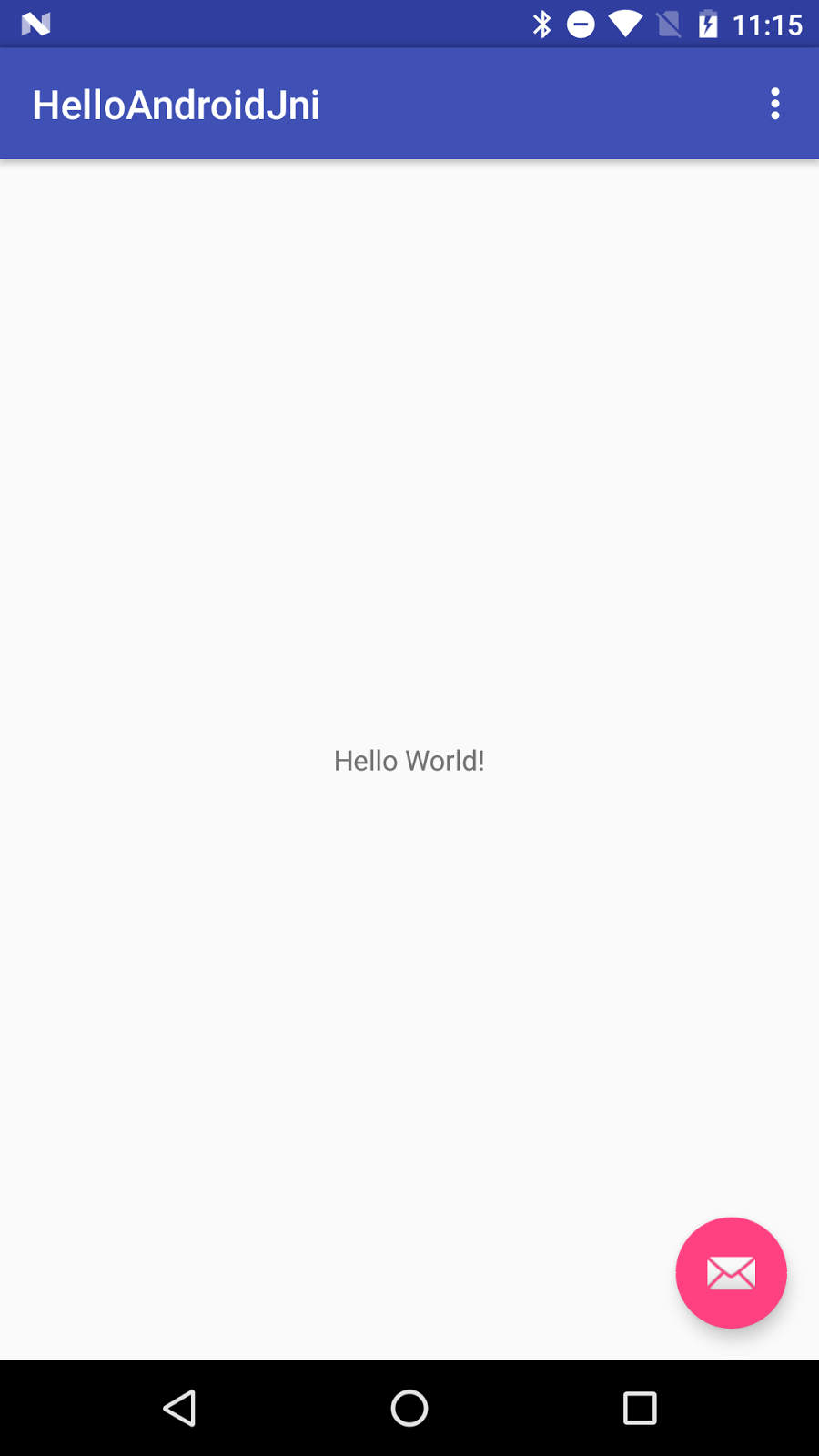
4. Add JNI Code Into Project
- Check the NDK Path.
Select the menu "File" > "Project Structure" >
"SDK Location", "Android NDK Location" if it is not
set yet, then click "...", and browse to your NDK location and
click "OK" (you may also choose "download").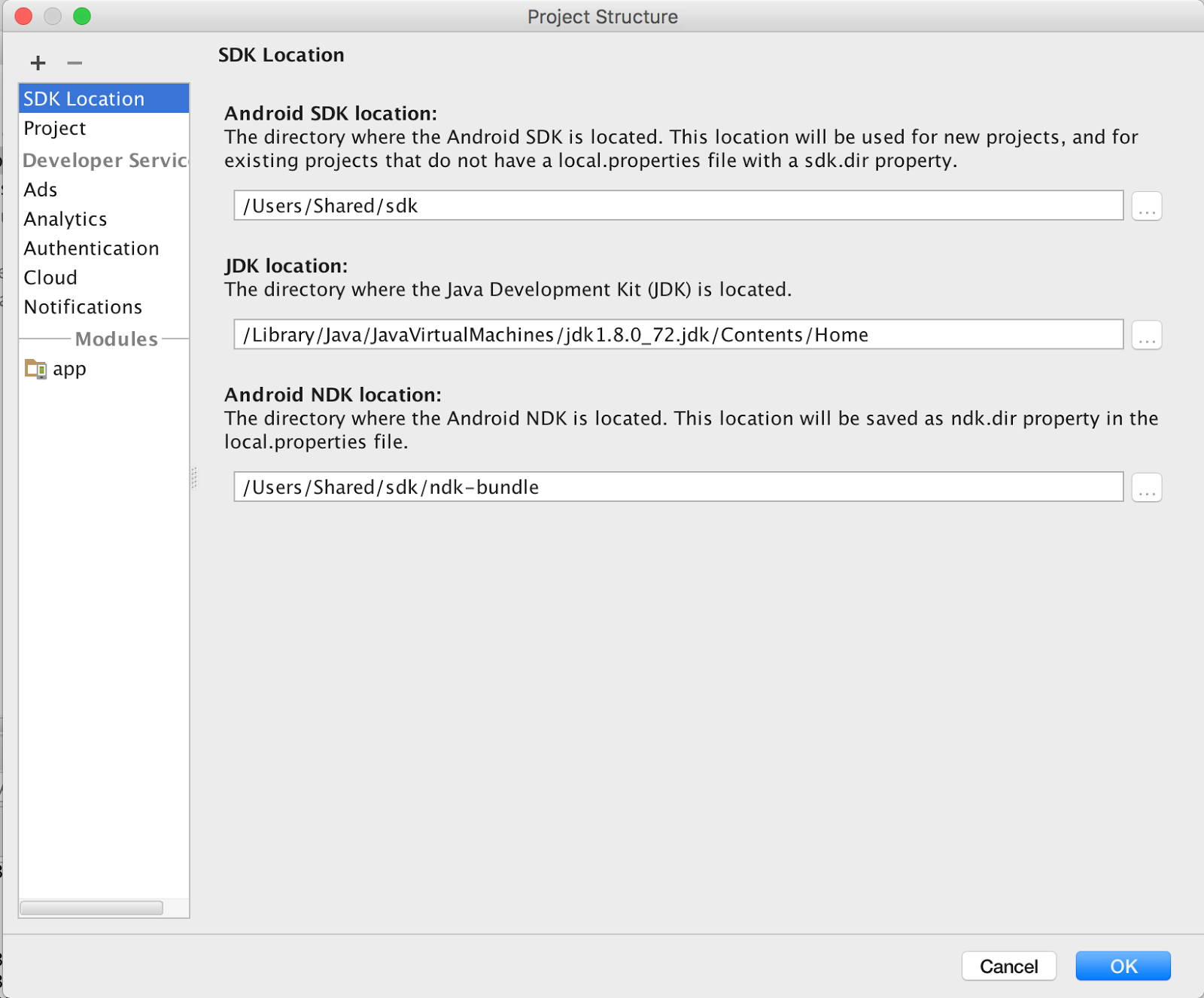
- Configure the module build.gradle to create
"hello-android-jni" shared lib.
Select Android Studio "Project" pane > "Gradle
Scripts" > "build.gradle (Module:app)", add the
following inside the "model" block, after "buildTypes" block.
buildTypes {
...
}
// New code
ndk {
moduleName "hello-android-jni"
}
// New code finished
- Add JNI function and load jni shared lib into project.
Select Android Studio "Project" pane > "app" >
"java" > "com.google.sample.helloandroidjni" >
"MainActivity", and add JNI function getMsgFromJni() and
System.loadLibrary() to the end of class MainActivity.
...
// new code
static {
System.loadLibrary("hello-android-jni");
}
publicnativeString getMsgFromJni();
// new code done
} // class MainActivity
- Sync , Build , there should be no errors from Android Studio.
Note:
- make sure library name is the same as moduleName inside build.gradle
- The "Build" step is just to build, do not load the built apk yet; if you load it, it will crash since there is no native implementation for getMsgFromJni() yet
- Generate the C/C++ prototype function for jni function getMsgFromJni().
In MainActivity.java file, "getMsgFromJni()" is highlighed with
red because Android Studio could not find its implementation; let's get it
implemented:
- Select function "getMsgFromJni()".
- Wait for context aware menu prompt

to appear. - Click on
 to bring up the popup
to bring up the popup

- Select "Create Function
Java_com_google_example_helloandroidjni_MainActivity_getMsgFromJni". - Android Studio creates a prototype function
for getMsgFromJNI() in hello-android-jni.c file under the "jni"
folder. Both got created at once!
#include<jni.h> JNIEXPORT jstring JNICALL
Java_com_google_sample_helloandroidjni_MainActivity_getMsgFromJni(JNIEnv *env, jobject instance) { // TODO return (*env)->NewStringUTF(env, returnValue);
}
- Replace "returnValue" in the above code with our own message:
// TODO
return (*env)->NewStringUTF(env, "Hello From Jni");
- Display our JNI message in the application.
- Add an ID to the existing TextView.
Open "Android Studio" pane, "res" >
"layout" > "content_main.xml"[if you have chosen
template "Empty Activity" in step "Create Java Sample
App", you file might be "activity_main.xml" instead],
select "design" view, and click or "Hello World",
inside "Properties" pane, put "@+id/jni_msgView" into "ID" field:[The other way is to directly add into "text" view, and put id
in with android:id="@+id/jni_msgView".] - Display our jni message in the TextView.
In MainActivity::onCreate() function, append following code to the end of
the function:
((TextView) findViewById(R.id.jni_msgView)).setText(getMsgFromJni());
- Click the Run
 button, you should see "Hello From Jni" in your target device.
button, you should see "Hello From Jni" in your target device.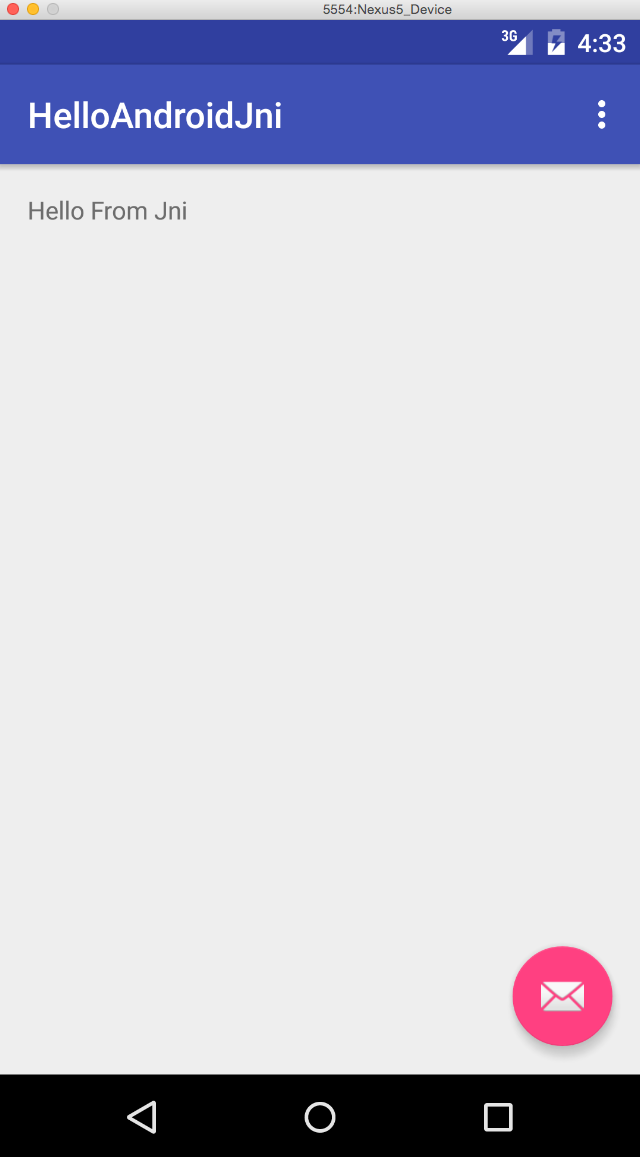
- Browse the Native Code
- Select "NewStringUTF" inside hello-android-jni.c, "right click" to bring up the pop-up menu.
- Select "Go To", and "Implementation(s)".
- You will see the function implementation of "NewStringUTF".
- Select other code to explore the native code browsing feature.
5. Debugging JNI Code
- Click the Run/Debug Configuration

[For Android Studio version earlier than 2.2, select . Android Studio
. Android Studio
auto-generates this native debug configuration when it detects JNI code.
In this config, debug configurations are enabled by default. If is not visible, close
is not visible, close
this project and reopen it with Android Studio, it will be there; Android
Studio version 2.2 integrated the debug functionality into app configure]. - Open hello-android-jni.c inside Android
Studio. - Click the left edge of the native code to set
a breakpoint:
- Click the Debug button

, your android device should prompt "Waiting For
Debugger" message: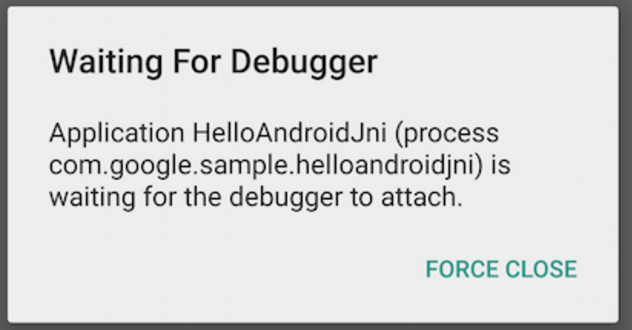
- Wait until Android Studio connects to the
debugger on your device ( it might take 1 - 2 minutes, depending on the
device and OS version ), and stops at the breakpoint.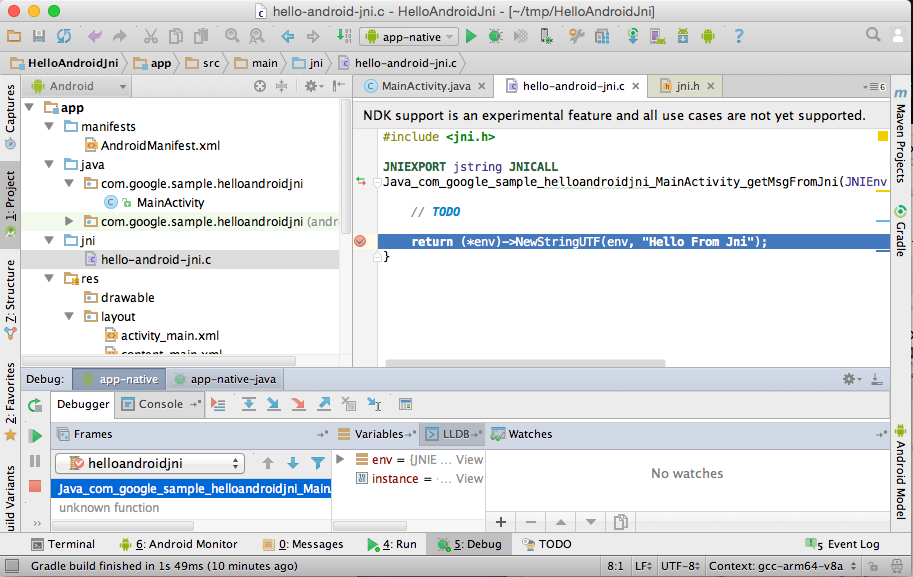
- Click "env" inside the
"Variables" window at the bottom pane of Android Studio to
observe contents of env pointer. - Click "+" at the bottom of the
"Watches" window (next to "Variables") and add "env", Android Studio will bring the content
of env into watch window. The values should be the
same as the values in "Variables" window. - Click the "F8" key to step over, and
menu "Run" > "Resume Program" to continue the
execution.
[Note: if you are using Android Studio
RC 1.5 or better, you can set a breakpoint on getMsgFromJni() in Java code and
"trace into" JNI code]
项目源码 https://github.com/leon-HM/HelloAndroidJni
最新文章
- NOI2001|POJ1182食物链[种类并查集 向量]
- webserer错误
- Ajax-jQuery实现
- 模拟京东商城登陆HttpRequest
- 关于iTerm和Zsh
- asp.net 后台使用js弹窗失效问题
- 仿QQ好友列表界面的实现
- 我的 Azure VM 为何会重新启动?
- hdu_5873_Football Games(xjb搞)
- Android开发模板代码(一)——简单打开图库选择照片
- 使用Visual Studio Team Services敏捷规划和项目组合管理(五)——组合管理
- D2
- WKWebView 加载本地HTML随笔
- 服务器重新启动,oracle数据库重新连接问题
- mac下的tcp抓包
- SqlServer数据库设计一个字段的值是由其他字段运算结果所得
- Anaconda完全入门指南
- Unity3D 学习 创建简单的按钮、相应事件
- plsql链接数据库配置
- 【POJ】2043.Area of Polygons